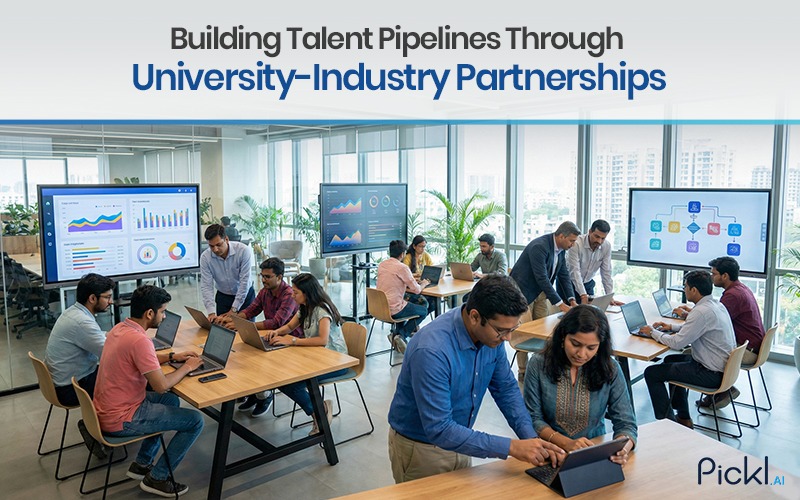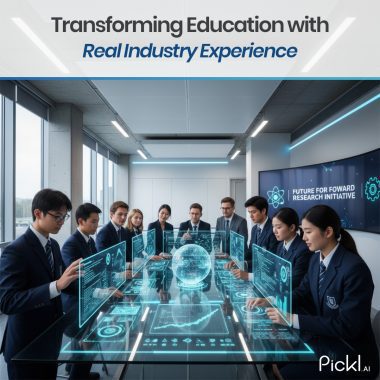Summary: This blog explores the critical role of university industry partnership in creating a sustainable talent pipeline. It details the benefits, challenges, and future trends of these collaborations, emphasizing their importance in developing skilled professionals for advanced tech fields like AI, Data Analytics, and Machine Learning for future innovation.
Introduction
In an era defined by rapid technological advancement, the demand for a highly skilled workforce has never been greater. Fields like Artificial Intelligence (AI), Data Analytics, Data Science, and Machine Learning are not just emerging trends; they are foundational pillars of the modern economy. This has created a significant skills gap, leaving many industries struggling to find qualified professionals.
To bridge this divide, a new educational paradigm is emerging, one that is built on the strategic collaboration between academic institutions and corporations. This synergy, known as a university industry partnership. It is laying the foundation for a new form of education that prioritizes practical skill development and creates a direct channel for talent to flow into the workforce.
What is a Talent Pipeline?

A talent pipeline is a proactive and strategic approach to recruitment that involves identifying, attracting, and nurturing a pool of potential candidates for future job openings within an organization.
Think of it as a well-managed reservoir of skilled individuals who are pre-screened and engaged, ready to fill roles as they become available. Unlike traditional reactive hiring, which begins only when a vacancy arises, building a talent pipeline ensures a continuous stream of qualified candidates, giving companies a significant competitive advantage.
The Importance of Talent Pipeline Development
In today’s fiercely competitive job market, talent pipeline development is not just a best practice; it’s a business imperative. The global talent shortage is a pressing issue for many organizations, making it challenging to find the right people with the right skills at the right time.
A robust talent pipeline mitigates this risk by creating a sustainable flow of top-tier candidates. This proactive approach to talent acquisition allows organizations to be more strategic in their workforce planning, ensuring business continuity and long-term success.
Benefits of Creating the Talent Pipeline
The advantages of a well-structured talent pipeline are manifold and impact various aspects of a business. Some of the key benefits include:
Reduced Time-to-Hire
With a pool of pre-qualified candidates, the time it takes to fill vacant positions is significantly reduced.
Higher Quality Candidates
Nurturing relationships with potential candidates over time allows for a more thorough assessment of their skills and cultural fit, leading to better hiring decisions.
Cost Savings
A proactive talent pipeline can reduce reliance on expensive recruitment agencies and advertising, thereby lowering the overall cost per hire.
Improved Diversity and Inclusion
By proactively sourcing from diverse talent pools, including universities with diverse student populations, companies can build a more inclusive workforce.
Enhanced Succession Planning
A strong talent pipeline is integral to effective succession planning, ensuring that there are always high-potential individuals ready to step into critical leadership roles.
Key Components of a Talent Pipeline Strategy
An effective talent pipeline strategy is a multi-faceted approach that involves several key components. At its core, it requires a deep understanding of the organization’s current and future talent needs. This involves identifying critical roles and the specific skills required to excel in them.
Proactive sourcing is another crucial element, which involves leveraging multiple channels to attract a diverse pool of qualified candidates. This is where the university industry partnership plays a pivotal role. By collaborating with universities, companies can gain direct access to emerging talent.
Other key components include continuous candidate engagement to keep potential hires interested and informed, and the strategic use of technology to manage and nurture the talent pipeline effectively.
Challenges in University-Industry Collaboration
Despite the immense potential, forging a successful university industry partnership is not without its challenges. Academia and industry often operate on different timelines and have distinct cultures and objectives. Universities typically focuse on research and theoretical knowledge, while industries are driven by immediate market demands and profitability.
Another significant hurdle can be intellectual property (IP) rights, with disagreements sometimes arising over the ownership of innovations developed through collaborative projects.
Furthermore, a lack of communication and mutual understanding can hinder the effectiveness of these partnerships. Overcoming these challenges requires a concerted effort to build trust, establish clear goals, and foster open lines of communication.
How Universities Benefit from Partnerships with Companies

The benefits of a strong university industry partnership are not one-sided. For academic institutions, these collaborations offer a wealth of opportunities, including:
Enhanced Curriculum Relevance
By working closely with industry partners, universities can align their curricula with the latest industry trends and demands, particularly in fast-evolving fields like AI and Data Science. This ensures that graduates equipped with job-ready skills.
Increased Research Opportunities and Funding
Industry collaborations can provide universities with additional funding and resources for research, enabling them to tackle complex challenges and drive innovation.
Real-World Experience for Students
These partnerships facilitate internships, co-op programs, and real-world projects, giving students invaluable hands-on experience
Improved Graduate Employability
Students who participate in industry-linked programs are often better prepared for the workforce and may even receive job offers from partner companies upon graduation.
Future Trends in University-Industry Collaboration
The landscape of university industry partnership is continuously evolving, driven by technological advancements and the changing nature of work. Some of the key future trends include:
Co-designed and Co-delivered Curricula
A deeper level of collaboration where industry experts actively involve in designing and even teaching courses, especially in specialized areas like AI and machine learning.
Growth of Experiential Learning
An increased emphasis on internships, apprenticeships, and project-based learning to provide students with practical, real-world skills.
Leveraging AI and Data Analytics
The use of AI and data analytics to personalize learning paths for students and better predict future workforce needs.
Focus on Lifelong Learning and Upskilling
The development of micro-credentials and professional development programs to support the continuous upskilling and reskilling of the existing workforce.
Conclusion
In the face of a rapidly changing technological landscape, the university industry partnership has emerged as a powerful model for education and talent development. By bridging the gap between academia and the corporate world, these collaborations are creating a more agile, skilled, and adaptable workforce.
For businesses, they offer a sustainable solution for building a robust talent pipeline of future leaders and innovators. For universities, they provide a pathway to greater relevance and impact. As we move forward, the strength of these partnerships will be a key determinant of our collective ability to thrive in the age of AI and big data.
Frequently Asked Questions
Why are talent pipelines important for universities and businesses?
For businesses, talent pipelines are crucial for ensuring a steady stream of qualified candidates, which reduces hiring time and costs, improves the quality of hires, and supports long-term workforce planning.
For universities, engaging in talent pipeline development through partnerships enhances their curriculum, provides students with practical experience, and boosts graduate employability rates.
What are the main benefits of building a talent pipeline through partnerships?
The main benefits include access to a diverse pool of emerging talent, the ability to shape curriculum to meet specific industry needs, enhanced brand visibility on campus, and the creation of a sustainable source of skilled employees. This proactive approach leads to higher quality hires, reduced recruitment costs, and better employee retention.
How can institutions get started with creating a talent pipeline through partnerships?
Institutions can start by identifying key industries and companies that align with their academic programs. They can then initiate conversations to understand their talent needs and explore potential areas of collaboration, such as guest lectures, joint research projects, and internship programs. Building strong, long-term relationships based on mutual benefit is essential for success.



